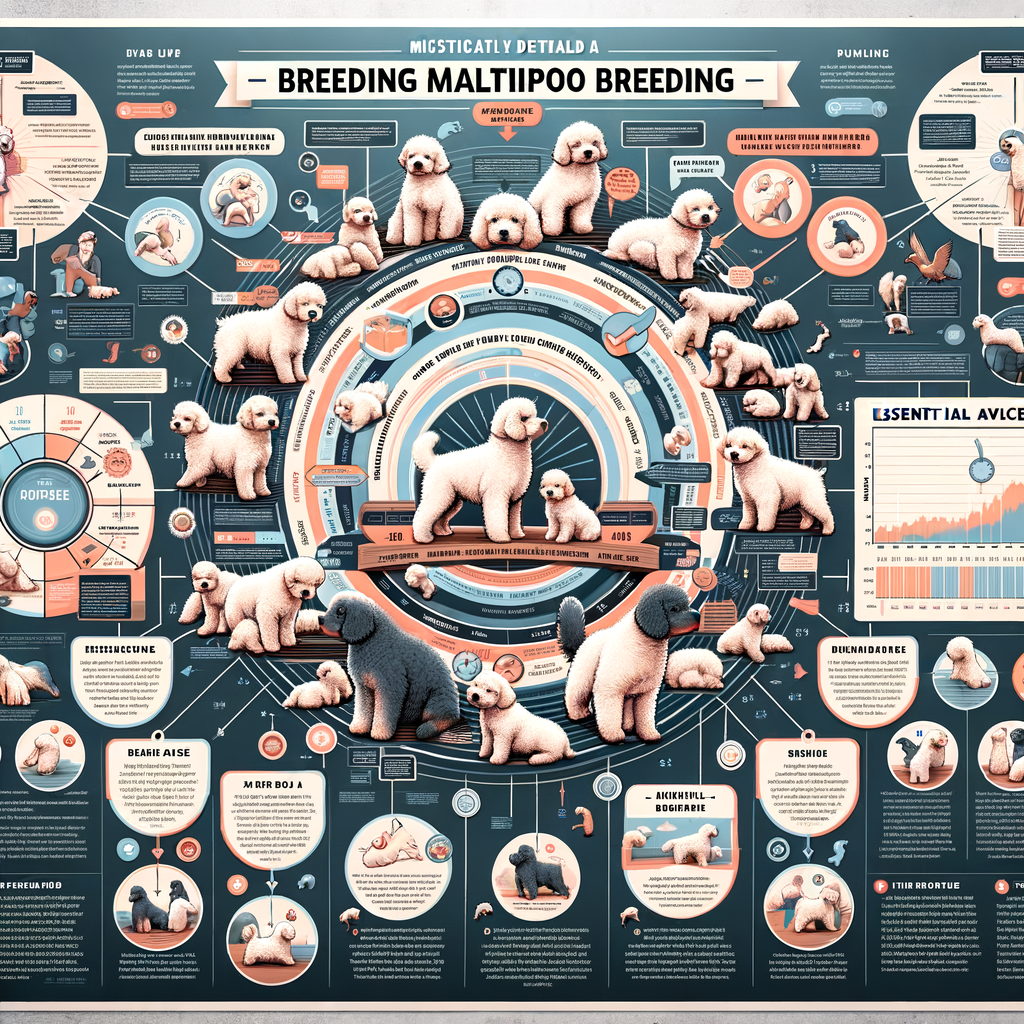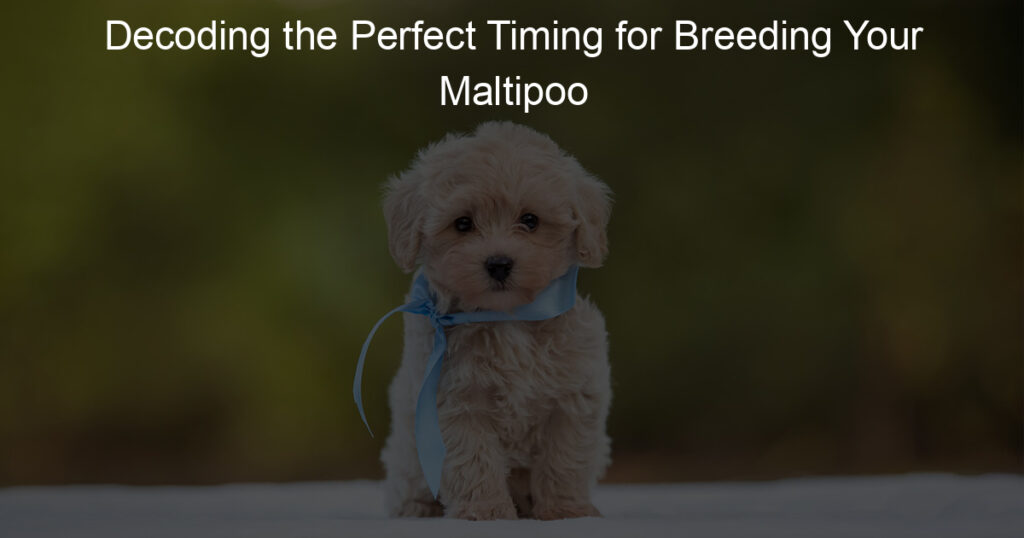
Introduction to Maltipoo Breeding Time
Welcome to our comprehensive guide on Maltipoo breeding time. This guide aims to provide clear and informative content on the importance of timing in Maltipoo breeding and the factors that influence the best time to breed Maltipoo. Let’s dive in!
- Understanding the importance of timing in Maltipoo breeding
- Factors that influence the best time to breed Maltipoo
The timing of breeding is crucial to the success of Maltipoo breeding. Breeding at the right time ensures the highest chance of pregnancy and the healthiest puppies. Breeding too early can lead to complications for the mother and the puppies, while breeding too late can result in missed opportunities and lower fertility rates. Understanding the breeding cycle of your Maltipoo is key to successful breeding.
Several factors determine the best time to breed Maltipoo. These include the age and health of the Maltipoo, the stage of the Maltipoo’s heat cycle, and the Maltipoo’s overall readiness for breeding. It’s important to consult with a vet to ensure your Maltipoo is at the optimal health and age for breeding. Additionally, understanding the signs of your Maltipoo’s heat cycle can help you identify the best time for breeding.
In conclusion, timing is a crucial aspect of Maltipoo breeding. It’s not just about breeding; it’s about breeding at the right time. By understanding the importance of timing and the factors that influence it, you can increase your chances of successful Maltipoo breeding.
Maltipoo Breeding Guide: When to Breed Maltipoo
Understanding the breeding cycle of a Maltipoo is a crucial part of successful breeding. This guide will help you understand the stages of the Maltipoo breeding cycle and the signs that indicate the start of the cycle.
Understanding the Maltipoo Breeding Cycle
The Maltipoo breeding cycle is a series of stages that a female Maltipoo goes through in preparation for potential pregnancy. It’s important to understand these stages to ensure the health and safety of both the mother and the puppies.
- Stages of the Maltipoo breeding cycle
- Signs indicating the start of the breeding cycle
The Maltipoo breeding cycle consists of four main stages: Proestrus, Estrus, Diestrus, and Anestrus. Proestrus is the beginning of the heat cycle where the female starts attracting males but isn’t ready to mate yet. Estrus is the stage where the female is receptive to mating. Diestrus is the stage following mating, and it lasts until the next heat cycle. Lastly, Anestrus is the period of rest between heat cycles.
There are several signs that indicate the start of the Maltipoo breeding cycle. These include changes in behavior such as increased urination, swelling of the vulva, and a bloody discharge. It’s important to note that these signs can vary from dog to dog, and not all dogs will exhibit all signs.
Understanding the Maltipoo breeding cycle is key to successful breeding. By recognizing the stages and signs, you can ensure that your Maltipoo is bred at the right time and in the right conditions.
Optimal Maltipoo Breeding Age
Understanding the optimal breeding age for Maltipoos is crucial for their health and the health of their puppies. Let’s delve into the details.
- Minimum Age for Breeding
- Maximum Age for Breeding
- Health Considerations Related to Maltipoo Breeding Age
The minimum age for breeding a Maltipoo is generally around one year. However, it’s important to note that just because a Maltipoo has reached physical maturity, it doesn’t mean they are ready for breeding. It’s recommended to wait until they are at least two years old to ensure they are emotionally mature and physically ready for the process.
The maximum age for breeding a Maltipoo is around seven years old. After this age, the risks associated with pregnancy and childbirth increase significantly. It’s always best to consult with a vet to determine if your Maltipoo is healthy enough for breeding, regardless of their age.
There are several health considerations to keep in mind when it comes to Maltipoo breeding age. Breeding too young can lead to complications during pregnancy and childbirth, while breeding too old can increase the risk of health issues for both the mother and the puppies. Regular vet check-ups, a balanced diet, and plenty of exercise can help ensure your Maltipoo is in the best health possible for breeding.
Remember, every Maltipoo is unique and what works for one may not work for another. Always consult with a professional before making any decisions about breeding your Maltipoo.
Maltipoo Breeding Tips: Ensuring Successful Breeding
When it comes to breeding Maltipoos, there are several factors to consider to ensure a successful process. Preparation is key, and it involves several steps that are crucial for the health and wellbeing of both the mother and the puppies.
Preparation for Breeding Your Maltipoo
Before you start the breeding process, it’s important to prepare your Maltipoo properly. This involves two main steps:
- Health checks and vaccinations: The first step in preparing your Maltipoo for breeding is to ensure that they are in good health. This involves taking them to the vet for a thorough health check. The vet will check for any potential health issues that could affect the breeding process or the health of the puppies. It’s also important to ensure that your Maltipoo is up-to-date with their vaccinations. This will help protect both the mother and the puppies from various diseases.
- Nutrition and exercise: Proper nutrition and regular exercise are also crucial for a successful breeding process. A healthy diet will ensure that your Maltipoo is in good physical condition for breeding, while regular exercise will help keep them fit and active. It’s also important to maintain a healthy weight, as obesity can lead to complications during pregnancy and childbirth.
By following these steps, you can help ensure a successful and healthy breeding process for your Maltipoo. Remember, preparation is key when it comes to breeding. So, take the time to prepare your Maltipoo properly, and you’ll be well on your way to a successful breeding experience.
During the Breeding Process
When it comes to the actual breeding process, there are two crucial aspects to focus on. These include monitoring the mating process and ensuring the comfort and safety of both dogs. Let’s delve into these points in more detail.
- Monitoring the Mating Process
- Ensuring the Comfort and Safety of Both Dogs
Keeping a close eye on the mating process is essential. This is not about invading the privacy of your dogs, but about ensuring that everything proceeds smoothly and naturally. It’s important to remember that this process can be stressful for both dogs, especially if it’s their first time. Therefore, your role as a responsible breeder is to provide a calm and supportive environment.
Observing the dogs will also allow you to notice any signs of discomfort or distress. If you notice any unusual behavior, it may be necessary to intervene or seek the advice of a veterinarian. Remember, the well-being of the dogs should always be your top priority.
Another important aspect of the breeding process is ensuring the comfort and safety of both dogs. This involves providing a comfortable and secure space for the dogs to mate. It’s also crucial to ensure that both dogs are healthy and in good condition before the breeding process begins.
During the mating process, it’s important to be patient and allow the dogs to take their time. Rushing them or forcing them to mate can lead to stress and potential health issues. Therefore, it’s best to let nature take its course and provide support when necessary.
In conclusion, successful breeding involves careful monitoring and ensuring the comfort and safety of both dogs. By following these steps, you can help ensure a successful and healthy breeding process for your Maltipoos.
Maltipoo Reproduction: What to Expect
Understanding the reproduction process of Maltipoos is crucial for any owner or breeder. This section will cover the pregnancy and birth stages, providing you with valuable insights on what to expect.
Pregnancy and Birth
From recognizing the signs of pregnancy to understanding the birthing process, here’s everything you need to know.
- Signs of pregnancy in Maltipoos
- Duration of pregnancy
- The birthing process
Just like humans, Maltipoos exhibit certain signs when they are pregnant. These can include changes in behavior, such as increased affection or lethargy, and physical changes like weight gain and enlarged nipples. It’s important to note that these signs can vary from dog to dog.
The gestation period for Maltipoos, like most dogs, is approximately 63 days. However, this can vary by a few days either way. It’s always a good idea to consult with a vet to ensure accurate tracking of the pregnancy.
The birthing process, also known as whelping, can be a stressful time for both the Maltipoo and the owner. It’s essential to prepare a quiet and comfortable space for your dog to give birth. The process can last anywhere from a few hours to a full day, depending on the number of puppies and the dog’s health. After birth, the mother will instinctively clean her puppies and begin to nurse them.
Understanding these aspects of Maltipoo reproduction can help ensure a healthy and successful breeding process. Remember, each dog is unique and may not follow these patterns exactly. Always consult with a professional if you have concerns.
Post-Birth Care
After the Maltipoo puppies are born, it’s essential to provide proper care for both the mother and the newborns. This care ensures the health and well-being of the mother and her puppies.
- Caring for the Maltipoo mother
- Caring for the newborn puppies
After giving birth, the Maltipoo mother needs special care. She may be tired and stressed, so it’s important to provide her with a quiet, comfortable space to rest. Make sure she has access to fresh water and nutritious food to help her recover and produce enough milk for her puppies.
Monitor her closely for any signs of distress or illness, such as loss of appetite, lethargy, or unusual behavior. If you notice any of these signs, contact your vet immediately. Remember, a healthy mother means healthy puppies.
Newborn Maltipoo puppies are very fragile and require careful handling. They should stay with their mother for the first few weeks as they need her milk for nutrition and antibodies to fight off diseases.
Keep the puppies in a warm, draft-free area as they can’t regulate their body temperature yet. Check them regularly to ensure they are feeding properly and gaining weight. If a puppy seems weak or is not feeding, seek veterinary advice immediately.
In conclusion, post-birth care for Maltipoos involves attentive care for the mother and her puppies. By providing the right environment, nutrition, and medical care, you can ensure that the mother and her puppies thrive.
Conclusion: The Importance of Timing in Maltipoo Breeding
In our journey through the world of Maltipoo breeding, we’ve learned a great deal. The importance of timing in Maltipoo breeding cannot be overstated. It’s not just about the breeding itself, but also about the care and attention that goes into ensuring a successful breeding process.
- Recap of key takeaways
We started by introducing the concept of Maltipoo breeding time, highlighting that it’s not a simple process, but one that requires knowledge, patience, and dedication. We then delved into the specifics of when to breed Maltipoo, emphasizing the importance of understanding the female Maltipoo’s heat cycle and the ideal age for breeding.
Our guide provided practical tips to ensure successful breeding, such as providing a comfortable environment for the dogs, monitoring their health, and seeking professional advice when needed. We also discussed what to expect during Maltipoo reproduction, including the stages of pregnancy and the care needed for both the mother and puppies.
- Final thoughts on Maltipoo breeding time
As we conclude, it’s clear that timing is a crucial factor in Maltipoo breeding. It’s not just about the right age or the right heat cycle, but also about the right care and attention at every stage of the process. Breeding Maltipoos is a responsibility that should be taken seriously, with the welfare of the dogs as the top priority.
Remember, every Maltipoo is unique, and what works for one may not work for another. It’s essential to understand your Maltipoo, be patient, and be ready to adapt as needed. With the right knowledge and approach, you can ensure a successful breeding process and the birth of healthy, happy puppies.








